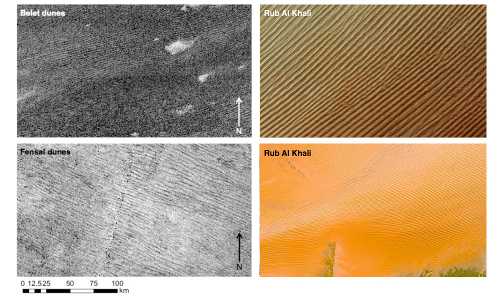The methane/ethane cycle we see on Titan is reminiscent of the water cycle on Earth, which is what people are really talking about when they refer to this frigid place as vaguely ‘Earth-like’ — this is not exactly a temperate climate! But we have a long way to go in understanding just how the cycle operates on the distant moon, which is why new work on Titan’s sand dunes is drawing interest. By studying the dune fields, we can learn about the climatic and geological history they depict and perhaps get clues about other issues, such as why Titan’s lakes of liquid ethane and methane are found mostly in the northern hemisphere.
What Cassini is showing us are regional variations among Titan’s dunes, a landscape feature that covers some 13 percent of the surface in an area roughly equivalent to that of Canada. But every time we run into an Earth analogue on Titan, we’re confronted with major differences. Titan’s dunes are made not of silicates but of solid hydrocarbons that wind up as tiny grains after precipitating out of the atmosphere. They’re also much larger than sand dunes on Earth, averaging 1-2 kilometers in width, hundreds of kilometers in length, and 100 meters in height.
Have a look at Cassini’s view of Titan’s dune fields as compared to what we see on Earth:
Image: Two different dune fields on Titan: Belet and Fensal, as imaged by Cassini’s radar. The image also shows two similar dune fields on Earth in Rub Al Khali, Saudi Arabia. Fensal is at higher latitude and elevation than Belet and clearly shows thinner dunes with brighter and wider areas in between, suggesting less abundant dune material in this region. Credit: NASA/JPL-Caltech/ASI/ESA and USGS/ESA.
This ESA news release points out that radar data from Cassini have allowed researchers to see clear correlations between the size of Titan’s dunes and their altitude and latitude. The major dune fields are all found in lowland areas, with dunes at higher elevations much more widely separated and, judging from the bright radar echo Cassini detects from them, covered by thinner layers of sand. Titan’s dunes are also largely confined to its equatorial region, in a band between 30°S and 30°N. As we move north, the dunes become narrower and more widely spaced.
The key may be Titan’s weather. Seasons here are just over seven Earth years long, and the elliptical nature of Saturn’s orbit results in shorter, warmer summers for the southern hemisphere. The result: The wetness of the surface in the southern areas from ethane and methane vapor in the soil is reduced. Drier sand makes for easier dune formation. “As one goes to the north, the soil moisture probably increases, making the sand particles less mobile and, as a consequence, the development of dunes more difficult,” says Alice Le Gall (LATMOS-UVSQ, Paris).
If Le Gall’s thinking is correct, the climate variation also could explain the location of Titan’s lakes and seas, found in the northern hemisphere largely because the soil would be moister there. “Understanding how the dunes form as well as explaining their shape, size and distribution on Titan’s surface is of great importance to understanding Titan’s climate and geology,” adds Nicolas Altobelli, ESA’s Cassini-Huygens project scientist. Thus the dunes of Titan, made from frozen atmospheric hydrocarbons, may help us in the continuing effort to piece together the moon’s methane/ethane cycle, a work in progress that is still a long way from completion.




I like the idea that a hydrological cycle applies not only to water.
Also, those radar images of Titan’s dunes compared to images of Earth’s sand dunes are quite impressive.
Just imagine the stunning wilderness landscape. Hollywood should send a robot photographer and charge admission for the documentary footage. Ditto for the Mars grand canyons. Do that one first. Get there before Nasa!
Wondering if there are any altitude maps out there for Titan. If there are, might use these in Terragen 2 to visualize these dunes as accurately as I can…
If not, will have to improvise, best guess for the altitudes! No vertical exaggeration — would like to render it as the eye would see it, with none of the misleading height exaggeration and garish colors some artists use.
The Dunes of Titan – There has to be a science fiction novel or story with that title. Or there will be. Or some day it will be the title of an in-depth report about actually exploring them.
Good point, Larry! I actually modeled the title after a Poul Anderson story, “The Snows of Ganymede.” Now we need the Titan equivalent.
Paul, here is a whole list of fiction about the Saturnian moon, including some with titles close to the one for this article:
http://en.wikipedia.org/wiki/Titan_in_fiction